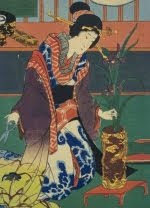Bridal Wreath Spirea (Spiraea arguta)
Vintage ikebana vase
Vintage ikebana vase
The vase or container is always an important and integrated part of an ikebana arrangement. Almost anything can be used as a container, but some vases are especially designed for ikebana use. In the 1950s and 1960s the modern ikebana schools started designing freestyle containers with striking shapes. Today these containers are appreciated again as they go very well with midcentury modern designs.
Sofu Teshigahara, founder of the Sogetsu school of ikebana was inspired by the new contemporary art movement in Europe after WWII. This biomorph vase designed by Sofu was named "Komochi" (子持) meaning Mother with Child. A soft egg shaped form is repeated in a smaller offshoot with identical shape, forming an organic vessel with two openings. The glaze is a pale grayish blue. I've also seen this vase with a black glaze, and also with two twin offshoots from the larger egg shape making it a vase with three openings.
Mother and child is an iconic motive with strong connotations to religious art. Kannon, the Japanese bodhisattva of love and compassion, is sometimes depicted with a baby boy either in her arms or beside her. She also appeares as a goddess delivering babies to women praying for a child. The Madonna with child is very prevalent in Christian iconography, divided into many traditional subtypes. A medieval sculpture in a church from my home region in Sweden made a strong impact on me as a child. The sculpture depicts St. Anna with her daughter Virgin Mary on her lap, holding the child Jesus. The mother and child motive has relevance to us all on a personal level. We are never done with the love and tension between generations.
In my ikebana arrangement mother and child are covered in a cloud of white Spirea flowers, reflecting the floating moment when the foliage starts to beak in spring. I made this ikebana for Mothers day but haven't had time to post it until now.
Sofu Teshigahara, founder of the Sogetsu school of ikebana was inspired by the new contemporary art movement in Europe after WWII. This biomorph vase designed by Sofu was named "Komochi" (子持) meaning Mother with Child. A soft egg shaped form is repeated in a smaller offshoot with identical shape, forming an organic vessel with two openings. The glaze is a pale grayish blue. I've also seen this vase with a black glaze, and also with two twin offshoots from the larger egg shape making it a vase with three openings.
 |
| "Kosodate Kannon", Kanon and child. Image credit The Walters Art Museum. |
 |
| "Anna själv tredje", Mattmar church, Sweden. Image credit: Lennart Karlsson/Historiska Museet. |













No comments:
Post a Comment